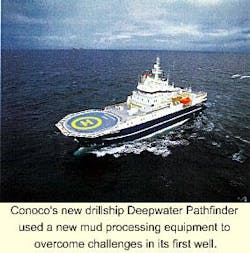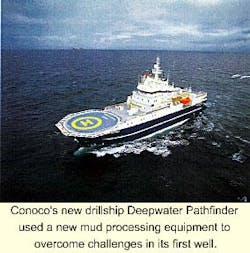Fluid design, mixing reduces screen blinding
The first well the new Deepwater Pathfinder drillship drilled in the deepwater Gulf of Mexico, Conoco's Magnolia prospect on Garden Banks 783, used new fluids processing equipment to handle a unique engineered mud system in the upper and intermediate hole sections.
While this setup operationally avoided many of the "teething problems" normally associated with new rigs drilling their debut wells, the Magnolia project specifically set new standards in drilling fluids management. In the process, the well, drilled in 4,668 ft of water, reinforced the value of calcium chloride/polymer mud systems in deepwater drilling.
The use of these brine-base systems throughout the deepwater Gulf of Mexico has been documented. However, until this well was drilled, blinding of the shaker screens potentially could result in severe mud losses, thereby negating many of the benefits of the system. Using a new mixing procedure, an improved formulation, and the Pathfinder's fluids processing system, the blinding problem was eliminated on the Magnolia exploration well, thus confirming that the losses encountered on previous wells could be avoided.
Calcium chloride brine-base mud systems were developed specifically for optimum shale inhibition and wellbore stabilization, particularly for the upper and intermediate zones of deepwater Gulf of Mexico wells. Reactive, gumbo-laden clays dominate those intervals, typically resulting in bit and bottom hole assembly (BHA) balling and gumbo accumulations in the riser and on the wellhead. Stuck pipe, lost circulation, inability to drill and underream simultaneously, difficulties in hole cleaning, poor core recovery, and out-of-gauge wellbores were among the difficulties that have restricted drilling efficiency and escalated drilling costs in the deep and ultra-deepwater Gulf of Mexico.
Option to PHPA systems
The calcium chloride/polymer mud system was developed specifically as an alternative to conventional salt-enhanced PHPA polymer mud systems, which were reasonably effective in minimizing hole stability problems. Unfortunately, they were unable to consistently eliminate the more costly gumbo problems.
When compared to sodium chloride brine, calcium chloride brine has been shown to be more effective for shale inhibition, primarily because of its high concentration of divalent calcium (Ca++) ions and high salinity. These traits effectively reduce the water activity of the brine. Saturated calcium chloride brine, for instance, has a water activity of 0.295, much lower than the 0.76 of its sodium chloride counterpart.
In previous field applications, the system consistently inhibited the formation from swelling or hydrating, thus providing a stable wellbore. It also has shown to be effective in encapsulating the drilled cuttings to keep them from hydrating and sticking together, or sticking to the many metal components of the well.
Despite its effectiveness in inhibiting the reactive clays and producing satisfactory penetration rates, earlier generations of the system experienced severe shaker-screen blinding, resulting in excessive mud losses over the shakers. Addressing the blinding problem by using coarser screens resulted in increased fluid losses and associated costs, and viscosity increases, primarily due to accumulation of low gravity solids in the mud.
The shaker screen blinding problem, which was a direct result of the strong elastic properties of the long-chain polymer, was investigated in a series of tests to determine if the formulation could be modified slightly to permit flow through the screens without sacrificing the encapsulating or inhibiting properties of the systems. The result was a new and unique encapsulating polymer, which when maintained in the 1.8-2.2 ppb range, has been shown to provide excellent encapsulation of the cuttings.
In order to successfully utilize the system, the rig had to be equipped to handle the high flow rates. The fact the Magnolia prospect was being drilled with new crews using a relatively unfamiliar mud system on a newly built rig with new solids control equipment raised a measure of concern at the onset. Although engineering analysis of the solids control equipment on the rig, which included two scalpers, four flowline cleaners, and two mud cleaners, concluded that the system would be capable of handling the mixing and screening requirements of the calcium chloride/polymer-base fluid system, there was still some doubt that screen blinding could be eliminated.
Magnolia drilling
To avoid the gumbo problems experienced in the offset wells drilled with sodium chloride/polymer mud, the newly engineered fluid system was selected for two hole intervals on the Magnolia well. Simultaneous drilling and underreaming was planned to minimize expensive trip time.
The first interval was 12¼ -in. by 20-in. to accommodate a 16-in. liner. The second interval was 14¾-in. by 17½-in. for setting a full string of 13 5/8-in. casing. Planned mud weights are 9.8-12.0 ppg.
Unlike previous wells employing the system, the polymers were premixed with a vortex-type-shearing hopper. In addition, a mechanical shearing pump was positioned directly over the pre-mixing tank, and used to complement the mixing hopper by maximizing shear of the polymer. For the initial displacement, 6,100 bbl of the calcium chloride system were premixed on shore, employing equipment identical to that on the rig.
After running the BOP and riser, the well was displaced with the 9.8 ppg calcium chloride/ polymer system prior to drilling the 20-in. casing shoe at 6,843 ft. Owing to the blinding problems experienced on previous wells, it was considered prudent to start with larger screens to avoid excess losses. Thus, the scalping shakers and flowline shakers were fitted with 10-mesh and 12-mesh screens, respectively. The mud cleaners were equipped with one 12-mesh and three 50-mesh screens.
With the initial drill rate controlled to 60-75 ft/hr, no problems with screen blinding was observed with flow rates up to 2,000 gpm across the shakers. The system exhibited excellent inhibition characteristics and produced discrete and dry cuttings over the shakers. The density of the fluid was 9.8-10.5 ppg.
The 2,579-ft interval was completed at 9,422 ft with no hole problems and at average rates of penetration (ROP) of 70 ft/hr. Moreover, no mud losses were recorded in the section, even when the shaker screens were reduced to 84-mesh and 110-mesh before reaching 7,500 ft. No gumbo problems were encountered and no gumbo buildup was evident on the BHA or underreamer.
Because of the excellent shale inhibition and ease of maintenance experienced in the preceding section, the system was also used in the subsequent 14¾ by 17½-in. section. While drilling out the 16-in. casing shoe, the system was pretreated with magnesium chloride to keep the pH below 9.0. Furthermore, the system showed no signs of contamination after drilling out cement in the previous section. Drilling resumed at ROPs up to 90 ft/hr, with high-viscosity sweeps pumped as required to ensure proper hole cleaning.
Optimum encapsulation of the cuttings at the shaker was ensured by monitoring and adjusting dilution rates on the basis of the ROP and the MBT and polymer concentrations. During this interval, it was shown that the cuttings integrity, dry inside, with visible encapsulating polymer on the outside, improved as the total dilution ratio approached 4 bbl/bbl of formation drilled. Correspondingly, the MBT levels were maintained at plus or minus5.
The encapsulation properties of the system were reinforced when the derrick shakers were fitted with screens as fine as 210-mesh with only minimal losses attributed to aggressive screening and an overall mud on cuttings retention estimated at 1.3-1.7 bbl mud/bbl of cuttings. Flow rates over the shakers were up to 1,500 gpm. No viscosity problems were encountered with the low wellbore temperatures after the well was static during trips.
The 4,035-ft section, which included a sidetrack around junk, was completed with no mud problems. Additionally, the excellent hole conditions attributed to the uniquely engineered mud was instrumental in successfully running and cementing the 135/8-in. casing.
Since hole cleaning is a critical factor when using this system in gumbo-laden intervals, the operator elected to rely on data generated from the mud company's proprietary software package. This software is designed specifically for calculating pump pressures, equivalent circulating densities (ECD) and equivalent static densities (ESD), as well as surge and swab pressures.
Fluid rheologies were measured at 40°, 60°, and 120° F and input to the model. The program's output was verified with real-time annular pressure measurements. This also provided the ability to monitor hole-cleaning efficiency. Weighted high-viscosity drillwater sweeps were pumped as required to verify the predicted parameters and assure proper hole cleaning. This ensured that adequate hole cleaning properties were maintained throughout both intervals.
Lessons learned
The mud losses experienced on previous wells employing the calcium chloride/polymer system, such as screen blinding, polymer depletion, solids build-up, and those associated with fluid loss or rheology control were avoided on this well. Thus, the Magnolia project reinforced that calcium chloride mud systems, used in tandem with a new and unique encapsulating polymer, is a viable option for the gumbo-laden intervals of deepwater Gulf of Mexico wells. Further, the successful and uneventful running of the system on the newbuild Deepwater Pathfinder has resulted in a number of recommendations that hold substantial promise for future wells, including:
- The vortex-type shearing hopper and mechanical shearing unit should be used to build the mud, both onshore and on the rig
- It is important to affect proper dilution to maintain polymer and product concentrations
- MBT levels should be maintained at plus or minus 5
- The selected rig must be equipped with efficient solids-control equipment
- Using a large pit system will allow for effective pit management
- Utilize good engineering practices, including periodic low viscosity/high viscosity sweeps to ensure hole cleaning
- Excellent communication and cooperation between the operator, rig crew, drilling fluids technical support group, and drilling fluids on site personnel is imperative.
Authors
Don Paul is a Staff Drilling Engineer assigned to Conoco's deepwater drilling team for the Gulf of Mexico, which is based in Lafayette, Louisiana. His team is utilizing the DP drillship Deepwater Pathfinder. Prior to this assignment, he worked for Conoco in the UK as part of the West of Shetlands deepwater team. Before joining Conoco in 1991, he spent 10 years working for Exxon in various drilling assignments.
Robert Mercer is a Project Engineer for M-I L.L.C.'s Southeast US Region, based in Lafayette, Louisiana. Presently, he is assigned to Conoco's deepwater drilling team for the Gulf of Mexico. He joined M-I in 1977 and has worked as a Field Engineer, Senior Engineer/Programmer, and senior Technical Services Engineer before transferring to his present position two years ago. Mercer is a graduate of Texas A & I, Kingsville, Texas with a BS in Education.

